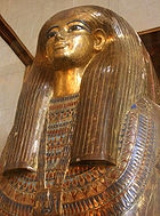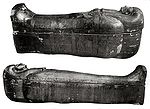
KV46
Encyclopedia
.jpg)
Valley of the Kings
The Valley of the Kings , less often called the Valley of the Gates of the Kings , is a valley in Egypt where, for a period of nearly 500 years from the 16th to 11th century BC, tombs were constructed for the Pharaohs and powerful nobles of the New Kingdom .The valley stands on the west bank of...
is the tomb of Yuya
Yuya
Yuya was a powerful Egyptian courtier during the eighteenth dynasty of Ancient Egypt...
and his wife Tjuyu
Tjuyu
Tjuyu was an Egyptian noble goddess, and the mother of queen Tiye, wife of pharaoh Amenhotep III...
, the parents of Queen Tiye
Tiye
Tiye was the daughter of Yuya and Tjuyu . She became the Great Royal Wife of the Egyptian pharaoh Amenhotep III....
, the wife of Amenhotep III
Amenhotep III
Amenhotep III also known as Amenhotep the Magnificent was the ninth pharaoh of the Eighteenth dynasty. According to different authors, he ruled Egypt from June 1386 to 1349 BC or June 1388 BC to December 1351 BC/1350 BC after his father Thutmose IV died...
, and King Ay
Ay
Ay was the penultimate Pharaoh of Ancient Egypt's 18th dynasty. He held the throne of Egypt for a brief four-year period , although he was a close advisor to two and perhaps three of the pharaohs who ruled before him and was the power behind the throne during Tutankhamun's reign...
, and grandparents of Nefertiti
Nefertiti
Nefertiti was the Great Royal Wife of the Egyptian Pharaoh Akhenaten. Nefertiti and her husband were known for a religious revolution, in which they started to worship one god only...
. It was discovered in February 1905 by James E. Quibell
James E. Quibell
James Edward Quibell was a British Egyptologist, born in Newport, Shropshire.He was educated at Adams' Grammar School and Christ Church, Oxford...
. Quibell was sponsored by Theodore M. Davis
Theodore M. Davis
Theodore M. Davis was an American lawyer and is best known for his excavations in Egypt's Valley of the Kings between 1902 and 1914.-Biography:...
, who published an account of the excavation in 1907.
Until the discovery of Tutankhamun
Tutankhamun
Tutankhamun , Egyptian , ; approx. 1341 BC – 1323 BC) was an Egyptian pharaoh of the 18th dynasty , during the period of Egyptian history known as the New Kingdom...
's tomb
KV62
KV62 is the tomb of Tutankhamun in the Valley of the Kings , which became famous for the wealth of treasure it contained. The tomb was discovered in 1922 by Howard Carter, underneath the remains of workmen's huts built during the Ramesside Period; this explains why it was spared from the worst of...
in 1922, this was the richest and best preserved tomb found in the valley, and the first to be found with major items in situ apart from the Tomb of Kha or TT8
TT8
TT8 or Theban Tomb 8 was the site of one of the greatest archaeological discoveries in ancient Egypt. This New Kingdom era tomb was one of the few tombs of Ancient Egypt's nobility to have survived intact down through the centuries - it was only discovered by Arthur Weigall and Ernesto Schiaparelli...
which was rather the tomb of an Egyptian nobleman. Located in a small branch of the main valley between two later Ramesside tombs, KV46 contained the mostly intact sarcophagi
Sarcophagus
A sarcophagus is a funeral receptacle for a corpse, most commonly carved or cut from stone. The word "sarcophagus" comes from the Greek σαρξ sarx meaning "flesh", and φαγειν phagein meaning "to eat", hence sarkophagus means "flesh-eating"; from the phrase lithos sarkophagos...
of Yuya and Tjuyu. It had been robbed in antiquity
Ancient Egypt
Ancient Egypt was an ancient civilization of Northeastern Africa, concentrated along the lower reaches of the Nile River in what is now the modern country of Egypt. Egyptian civilization coalesced around 3150 BC with the political unification of Upper and Lower Egypt under the first pharaoh...
(probably at the time of the construction of the later tombs) of most of its jewellry but the looters were not able to remove Yuya and Tjuyu's funerary masks.

External links
- Theban Mapping Project: KV46 - Includes detailed map of the tomb.

